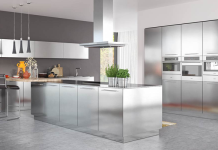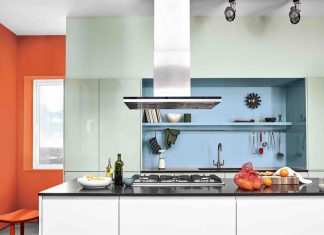The choice of materials in kitchen design significantly influences both the aesthetics and functionality of the space. In particular, the selection of metal—whether for appliances, sinks, a range hood, or a countertop—can dramatically alter the room’s character. Two popular choices, copper and stainless steel, offer distinct advantages and present unique aesthetic appeals. This article will compare these metals and provide some insights into which might be best suited for your kitchen.
1. Durability
Given the kitchen’s high-traffic nature and frequent use, durability is a key consideration. Stainless steel is highly durable, known for its strength and resistance to rust and corrosion. It stands up well to the demands of a busy kitchen, resisting dents and scratches that can occur from daily use. This durability, combined with its heat resistance, makes stainless steel a popular choice for appliances, sinks, and countertops.
Copper, while softer than stainless steel, is also extremely durable—with a twist. Over time, it develops a patina—a thin layer that forms on its surface due to oxidation. This acts as a protective coating, helping to resist corrosion and masking minor scratches, dings, or stains. Additionally, copper sinks are generally thicker than their stainless steel counterparts, which can increase their durability and longevity.
2. Aesthetics
When it comes to aesthetics in kitchen design, both copper and stainless steel present characteristics that can dramatically influence the look and feel of the space. Stainless steel, with its sleek and shiny finish, is often associated with a modern industrial or commercial kitchen aesthetic. It pairs well with a wide range of colors and finishes, making it a versatile way to add a contemporary touch to any kitchen.
On the other hand, copper exudes a warm, rich glow that can infuse a kitchen with a sense of rustic charm or vintage elegance. The patina that develops on copper over time adds an antique-like character that can soften the starkness of a modern design or enhance the cozy feel of a traditional kitchen. It is particularly effective as an accent, adding a touch of warmth that contrasts beautifully with neutral color palettes.
3. Maintenance
When it comes to maintenance, stainless steel is known for its low maintenance requirements. Resistant to both rust and stains, it can typically be cleaned with a soft cloth and mild detergent. If disinfecting and sanitizing are necessary, stainless steel can withstand harsh cleaning products such as bleach. However, it does tend to show water spots and fingerprints readily, which can make it hard to maintain a polished finish.
Meanwhile, copper requires a bit more care to maintain its appearance. It reacts with acidic substances, which can cause discoloration if not cleaned promptly. However, the evolving patina that copper develops makes minor stains and discolorations less noticeable and even part of the material’s character. Because of this, harsh chemicals or abrasive cleaning tools can damage copper’s surface, so more natural cleaning methods are recommended.
4. Sustainability
From a sustainability perspective, both copper and stainless steel have positive attributes. Both materials are infinitely recyclable, meaning they can be reused without losing quality or purity. Recycling copper uses only a fraction of the energy required to mine and process new copper, making it an environmentally friendly choice. Similarly, stainless steel’s recyclability reduces the need for mining raw materials and minimizes waste in landfills.
As a responsible consumer, it is best to avoid materials that contribute to environmental degradation. The most reliable way to find out if either material is recycled is to ask the manufacturer or supplier directly. You might find this information on their website or by contacting their customer service. Many companies committed to sustainability will be happy to specify the percentage of recycled content in their materials or products when asked.
5. Cost
When comparing the cost of copper and stainless steel in kitchen design, several factors come into play. In general, copper tends to command a higher cost than stainless steel. This is partly due to its unique aesthetic qualities, which give it a higher resale value. Many copper kitchen fixtures, such as sinks and range hoods, are also often handcrafted and custom-made to fit a particular kitchen aesthetic, which can add to their overall worth.
On the other hand, factory-manufactured stainless steel is typically less expensive. Its cost-effectiveness, combined with its durability and easy maintenance, makes it a popular choice for many basic kitchen applications. That said, you should note that costs can vary widely depending on the specific item, its size and complexity, and the quality of the material. Therefore, despite the general trends, prices can differ based on products and manufacturers.
How to Choose?
Stainless steel, known for its durability and low maintenance, offers a sleek, modern aesthetic and is generally cheaper. It is easy to incorporate into a standard kitchen and is suitable for a range of applications. Copper needs slightly more care but exudes a warmth that adds a rare distinctive charm. It is best for people who are willing to invest in an item of higher quality and are seeking a more customized and striking kitchen aesthetic.
Ultimately, the choice between copper and stainless steel depends on personal preference, budget, and the demands of your kitchen. Both materials, when used thoughtfully, can create a beautiful, practical, and sustainable kitchen that will serve you well for many years.















